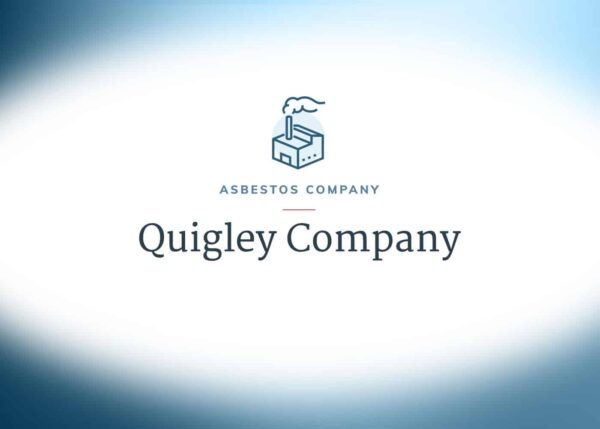01. History of Asbestos Use
Quigley Company History of Asbestos Use
Quigley Company started as a small operation in 1916, producing various refractory products for industries known to use high heat in their processes, like steel mills. The company quickly became one of the dominant manufacturers in the field, supplying goods for businesses in America, Canada and Europe.
Quigley Co. continued to expand its offerings of refractory cements and sealants. It also developed one of its most popular products, Insulag, which was used as an insulator in high-heat environments. All of these materials contained asbestos from the mid-1930s until the late 1970s. The products were widely used during this time, and the company continued to grow. Pfizer & Co., Inc. (now known as Pfizer) acquired the company in 1968 to expand its mineral and metals division.
However, by the 1990s, Quigley Company was essentially nonoperational. Pfizer had transferred all assets out of the company and stopped operations altogether in its short-lived mineral and metals division. Although Quigley was defunct for over a decade, it still remained an issue for Pfizer as the number of claims mounted for past asbestos exposure. Quigley Company’s 40 years of asbestos use caught up with them. Past employees, as well as workers in other industries, and their family members began to develop asbestos diseases as a result of working with or using its products.
In 2004, Quigley Company filed for bankruptcy, as the lawsuits and cost of litigation continued to grow.
Resources for Mesothelioma Patients
02. Asbestos Products
Quigley Company Asbestos Products
About twenty years after the company was founded, it began to use asbestos in a variety of its products. Because asbestos was cheap, accessible and naturally fire-resistant, it was the perfect additive to the company’s line of refractory goods. Reports show the company continued to use the mineral until around 1977, despite likely being aware of the health risks of asbestos by 1959.
03. Occupational Exposure
Quigley Company and Occupational Exposure
Use of Quigley Co.’s asbestos products spanned across numerous industries, particularly iron, steel, metal and glass melting. Because all of these workspaces often relied on high temperatures for their production processes, Quigley’s refractory products were frequently used across the United States, as well as in other countries. As a result, employees of Quigley Company and other companies in these industries faced exposure on the job every day. Workers, as well as their loved ones, may still be at risk of exposure to these products today.
04. Asbestos Litigation
Asbestos Litigation Against Quigley Company
Quigley Company was first named as a defendant in an asbestos claim in 1979, just a few years after they stopped using asbestos in their products. The number of lawsuits grew very quickly, increasing by the thousands. Although the company ceased operations by 1991, Pfizer went through the proper legal proceedings to resurrect its subsidiary. As a result, Quigley Co. filed for bankruptcy in September 2004 to help with the growing legal costs.
At the time Quigley Co. filed for bankruptcy, they were facing 411,110 asbestos lawsuits.
Pfizer was a co-defendant in 280,343 of the claims.
Court estimates suggested that the outstanding claims against Quigley at the time of filing were nearly $1.3 billion, when using historic payment amounts. It was also estimated the company would be named as a defendant in at least 261,567 claims through 2052, worth at least $3 billion.
However, bankruptcy negotiations proved difficult. Lawyers in bankruptcy court contested that the bankruptcy filing and reorganization plan was developed in bad faith by Pfizer to protect itself from the litigation costs. The plan was deemed as not being “fair and equitable,” as required by law, and also determined that the plan was not feasible given Pfizer’s proposed financial contributions.
As such, Quigley’s Chapter 11 Bankruptcy plan was not approved until June 2013. Pfizer contributed $964 million at the time for the reorganization plan, as well as an estimated additional $1.25 billion in settling a number of other pending asbestos claims. Once the plan was approved, the Quigley Company, Inc. Trust was also formed.
05. Asbestos Trust Fund
Quigley Company Asbestos Trust Fund
The current payment percentage for approved claims is 3.6 or 14.5%, depending on type of claim.
The Quigley Company, Inc. Asbestos Trust was created in 2013 and began accepting claims in August 2014. The asbestos trust was initially funded with $569 million to cover settlements for pending and future asbestos claims. The payment percentage is currently set at 14.5% for non-releasing asbestos claimants and 3.6% for releasing asbestos claimants. This ensures sufficient funds for future claims. However, the amount of compensation each claimant receives can vary. Payment may be higher than these base values depending on a number of factors including their diagnosis, their asbestos exposure history, claimant’s age and their law firm’s settlement history.
The Quigley Asbestos Trust is still active and accepting new claims. If you believe you or a loved one is entitled to compensation, learn how a mesothelioma lawyer can help.




